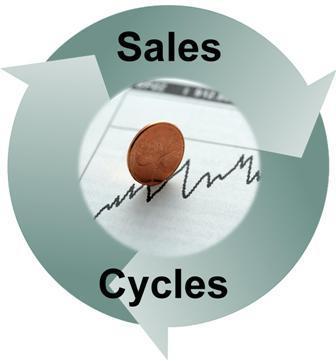
Is there anything you can do about your sales cycle? We will discover there are many patterns in the sales world. If we understand the patterns and what causes them, we have a chance to shorten the sales cycle.
Many salespeople believe that their sales cycle pattern is set, and it can’t be sped up or done differently. They are convinced that, “It is what it is,” so they follow the outline that has been laid out before them, convinced that they are powerless to change things. The reason that the sales cycle doesn’t change is salespeople seldom try anything new or different to reduce the length of time it takes to close the deal. They guide the prospect through multiple meetings with many different people, followed by the process of making a formal proposal. The sales cycle can’t get shorter if we don’t look for ways to improve it. Many times the sales cycle can be changed if the salesperson makes an effort to change it. This doesn’t mean that every sale (in every kind of industry) can be closed in only one or two calls. Some sales naturally take longer than others; however, with some effort and strategy every sales cycle can usually be shortened.
Sales cycles are rarely designed to be efficient. They tend to follow a structure that has been developed over time. One salesperson does what the others have done, which is based upon what has been done over and over. Try making an effort to identify where the sales cycle is becoming hung up. Ask yourself whether there is a way to eliminate the bottleneck, or at least help it along. (Chances are that you will identify several things being done that are not totally necessary.) Be sure to be realistic, though. A sales cycle that usually includes five meetings and a formal proposal, followed with an elaborate presentation to a committee, will not become a one-call close. Put some thought into it, and determine whether five meetings could become three or four. Decide what needs to happen to make that a reality. Find a few things that could happen better and work more efficiently, and that should make a big difference in how quickly you can progress through the sales cycle.
So how do you put your new strategy into action? You’ve already completed the most difficult part because you have developed a plan for what the sales cycle should look like. Now, the next step is to guide the prospect into following your plan. To accomplish this, you have to first make the prospect aware of the process. For example, if you want to see two people at once instead of meeting with each one separately, you need to let them know this in advance. You also have to be firm. Don’t allow them to shift back and forth about who will be there. You are the expert. Guide them. Use the word “typically.” This word sets the standard and presents the prospect with the norm. Most people are reluctant to go against the grain. If you present something as “what is typically done,” prospects will generally agree. This can enable you to guide them into a more efficient sales cycle, which in turn closes the deal sooner. If you make an effort to shorten your sales cycle by making a plan and sticking to it, “typically” you will be successful.

